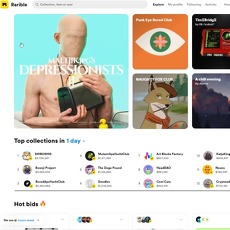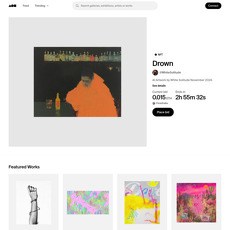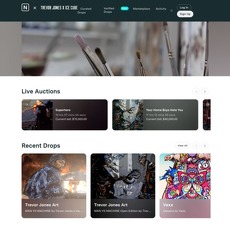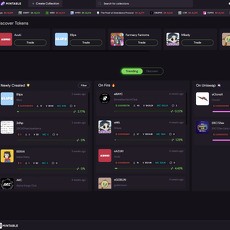NFT Art (non fungible tokens) - What is NFT?
Undoubtedly, non-fungible token (NFT) is one of the most exciting and appealing use cases of blockchain because it enables features that are critical to the ongoing push for digitization. NFT unlocks the possibility of initiating scarcity and uniqueness in the digital world. Therefore, it comes as no surprise that the technology has become a mainstream sensation with high profile individuals and brands showing their readiness to join the bandwagon.
From what we have learned so far, the entirety of the NFT buzz is fueled by investors’ readiness to pay outrageous sums for a piece of digital artwork or item they consider prestigious enough to attract a higher fee on the secondary market. And true to the wild-west nature of the crypto space as a whole, the NFT sector has been flooded with thousands of projects seemingly looking to capitalize on the current appeal of NFTs.
As such, it is necessary for new entrants to fully grasp the concept of NFTs before going ahead to invest their funds in some hyped up NFT offering. More importantly, you need to research projects and platforms to have an idea of how they work and analyze their viability. To this end, we have created a complete NFT guide where you can access all of the information you need to navigate the NFT sector safely. Here, we will introduce you to the core principles of NFT and explore some of the top websites operating in the space.
What is NFT?
You must have heard of how NFT-based digital items have sold for millions of dollars. Well, this has forced everyone to take notice of the emerging technology and the perceived advantage it offers the average NFT holder or issuer. (NFT guide 2022)And so, the question is: What is NFT and why has it become a global phenomenon?
Simply put, an NFT is a technology that enforces the ownership and uniqueness of items, whether they are digital or not. You see, NFT’s main characteristic is non-fungibility. Therefore, unlike digital and traditional currency, they are not interchangeable. Understand that currencies like bitcoin and the US dollar are fungible because their units are interchangeable. For example, 1 BTC is always equal to another 1 BTC, similar to how 1 USD is equal to another 1 USD. In essence, when you borrow 1 BTC, you do not need to pay the lender back the exact same coin you borrowed. In this scenario, any 1 BTC would suffice.
However, when it comes to NFTs, the opposite is the case. Note that each NFT comes with unique identifiers that make them differentiable from other NFTs. As such, no two NFTs are the same, even if they look similar in appearance. There is always a way to tell the difference between two or more NFTs, which is why it is difficult to use them as a payment medium. In summary, NFTs preserve the uniqueness of digital assets. With this, it is impossible to mistake a digital asset for another as they come with information that allows us to decipher their authenticity and distinctiveness.
Therefore, you can easily differentiate between a series of limited NFT offerings with similar traits. In other words, even when NFTs are part of a limited series of collectibles, you can confirm the individuality of each. For instance, the NFT could be 001/1000 of the series. Hence, how people will value it will be different from how they value NFT 079/100 of the same series, even though they have the same traits.
How do NFTs work?
From our short explanation on how NFT works, you will notice that NFT offers a way to establish the uniqueness of digital items. Before now, it was impossible to implement and validate unique traits of digital items, including music, arts, collectibles and so on. With NFT, it is now possible to attach metadatas that anyone can easily verify information like the identity of the creator, the day it was created, and sometimes, the signature of the creator. And you may be wondering: what is the guarantee that this information is tamper proof?
NFT exists on the blockchain. And just as digital assets like bitcoin and ethereum depend on the security infrastructure of a blockchain network, NFTs also rely on the same system. In other words, the metadata or unique identifier that sets each NFT apart is stored on a distributed ledger that is almost impossible to forge or delete. With this system, NFTs are not subject to centralized database frameworks that could undermine their safety. Instead, all the data that backs up these NFTs are stored on databases spread across a blockchain network to ensure that there is no single point of attack.
When you create a NFT, you automatically enable provable footprints that show the transfer of ownership of a digital or real world item. The implementation of these footprints on the blockchain eliminates the occurrence of fraud on the part of the creator. You can easily trace a digital asset to its origin and in the process have a clear view of how the item has changed hands over the years.
Bearing this technical marvel in mind, NFTs have understandably enabled a framework for monetizing real world and digital assets. Here, you only need to initiate a process that creates a tokenized version of the item in question and immediately establish the ownership of the said asset on the blockchain.
Speaking of blockchains, note that there are several types of NFT-compatible blockchains available today. Notably, the most popular is the Ethereum blockchain which was the first crypto ecosystem to introduce a standard, called Ethereum Request for Comment 721 or ERC721, for creating NFTs. Other examples are Binance Smart Chain, Solana, and Cardano. Before you begin to engage in the selling and buying of NFTs, be sure to understand strengths and weaknesses of each blockchains as it is presently difficult to switch in between two or more chains.
Why are NFTs so appealing?
As mentioned earlier, NFTs reinforces the ownership of digital and real world assets. This is a very important characteristic, especially in a time where just anyone can copy a file online without acknowledging the real owner or the creator. Thanks to the advent of NFTs, we can distinguish between the original copy from the duplicates. This is similar to how artists put their signature on their original creation like physical paintings, which are later sold to collectors or art lovers. With this, the buyer can rest assured that the painting he is buying is authentic. However, this does not mean that it is impossible for anyone to print a copy of the same painting on the internet. The difference is that unlike the buyer of the original copy, the random internet user that downloads a copy, cannot experience the level of prestige bestowed upon the current owner of the original painting. And so, NFT helps reassure buyers that they are not buying counterfeits.
Another important factor that has since propelled the NFT narrative is its ability to enable rarity, especially in the digital world. Now more than ever, there is the need to implement scarcity such that collectibles and other exclusive assets can be replicated in the digital world. Note that rarity is one of the core factors that determine the value of collectible items like baseball cards. Without scarcity, these items cannot retain a high market value nor would they evoke the sort of emotions that they normally inspire. Scarcity would most likely cause the price of these assets to increase, particularly when there is a high demand.
Lastly, NFT provides the uniqueness needed to differentiate between two similar assets. Collectibles are sometimes a collection of identical cards or assets. The sequential arrangement of these series of collectibles is the only way to identify each. NFTs have taken this to a whole new level as creators can add metadata that efficiently preserve the individuality of each NFTs whether they are part of a collection or are standalone NFT offerings. All in all, there is no way two NFTs can ever be the same.
What are use cases of NFTs?
The NFT sector has grown exponentially in the last couple of years, with developers increasingly expanding the scope of the technology such that we can use NFTs in our daily lives. Below are some of the applications that are already making a splash.
Crypto Art
Crypto art is perhaps the most popular use case of NFTs, even as artists continue to showcase their talents and monetize them with the help of blockchain technology. The idea is to create a piece of art (be it an artwork, a music or a video) mint the NFT versions on the blockchains and put them up for sale. Understandably, this possibility has boosted the digital art landscape, with thousands of digital artists coming to terms with a new order where they can independently market their creations. Before all this, artists have had to rely on the services of intermediaries, including auction houses. In essence, they had no other choice to split profits with middlemen.
Since NFT offers a self-initiated method of accessing potential buyers, it is no longer necessary for artists to utilize the services of auction houses. All they need to do is create the NFT version of their artworks and list them on NFT marketplaces where potential buyers can view and acquire them. In summary, the art community has found an easier way to put their works out there and pocket most of their profits. More importantly, they can take advantage of blockchains’ smart contracts to ensure that they receive a percentage of the revenue generated from sales. In other words, whenever the NFT is sold on the secondary market, a share of the revenue is paid to its creator. This system allows issuers to earn royalties as long as their NFTs continue to change hands.
NFT games
Other promising applications of NFTs that have piqued a lot of interest are NFT-based games. What we have come to understand is that the ownership and scarcity elements that NFT offers can help improve our gaming experience. You know all those in-game assets that you either earn or purchase with special coins? What if we told you that you can outrightly own them and even earn real money by selling them on either the game's in-house marketplace or a secondary platform.
By using NFT as the framework to anchor a gaming economy, gamers can now earn while they enjoy their favorite games. To make this possible, game providers only have to tokenize their in-game assets, including avatars and weapons, such that users that purchase or unlock them own them outrightly. As such, they can choose to sell it or trade them in for even more perks. In some cases, the game provider implements special traits that let gamers breed other NFT-based assets. Regardless of the type of traits of the NFT, the goal is to provide gamers with the opportunity of earning while they play.
Decentralized finance
Surprisingly, two of blockchain’s hottest applications have begun to collaborate to great effects. Since the beginning of 2020, we have witnessed a growing attempt by developers and crypto entrepreneurs to merge the strengths of decentralized finance (DeFi) and NFTs to create ecosystems where users can access multiple yield generating opportunities. For instance, there is the possibility of collateralizing your NFTs to access loans. This opportunity, in particular, eliminates the need to sell NFTs to raise funds. All you have to do is lock the NFT on a DeFi protocol as collateral and receive an amount that is a fraction of what your NFT is worth.
Although many of the protocols advertised as a mix between NFT and DeFi are still tentative, there are enough reasons to believe that they would unlock the next phase of growth for both crypto sectors.
Digital identities
NFTs have also been teased as a potential solution to eliminate some of the issues associated with digital identities. It is worth mentioning that digital identity systems can capitalize on the immutability of blockchain data to reduce the occurrence of identity fraud.
Tokenization
Importantly, NFTs provide the means to tokenize real world assets. In some cases, these assets are fractionalized so that two or more investors can jointly own such real world assets. Think of it as distributing the ownership of a single asset among several individuals. With this system, those that cannot afford to purchase assets outrightly can opt to partly own them.
What is the history of NFT?
Contrary to what many believe, the concept of NFT has been around for a while now. Interestingly, the first variant of non-fungible digital assets surfaced in 2012 when developers tried to use small denominations of bitcoin to represent real world assets. This project, called Colored Coins, tried to expand the functionalities of the Bitcoin network. After years of exploring this concept, it became clear that the infrastructural design of the Bitcoin network was not compatible with such features. However, this concept later went on to inspire more variants of distinguishable digital assets.
The first to come online was Counterparty, a peer-to-peer financial and trading platform that was originally launched on the Bitcoin network. Counterparty was instrumental to the introduction of in-game assets on the blockchain in 2014, particularly trading cards. In 2016, the platform began to support Rare Pepes. This dynamic application was replicated on the Ethereum ecosystem in 2017. Then came CryptoPunks, a collection of pixelated pictures of unique characters, which are widely considered the first implementations of NFT on the Ethereum blockchain. However, note that CryptoPunks launched before the Ethereum NFT standards were introduced. Therefore, CryptoPunks are not ERC721 tokens per se. Note that CryptoPunks remains one of the most valuable NFT collections presently.
Due to the appeal of tokenized assets on the Ethereum blockchain, the development team of Ethereum decided to set unique token standards (ERC721) that would make it easier for developers and users alike to engage with NFTs. Undoubtedly, this development marked a turning point in the NFT narrative as it ushered in the first wave of NFT-based projects that gave us a taste of how impressive NFTs can be. At the forefront of this renaissance was Crypto Kitties. Afterwards, we began to witness an influx of experimentation by digital artists which later fueled the NFT boom of 2021.
Ever since the ERC721 standard launched in 2017, the NFT sector has exploded exponentially, with some digital assets selling for tens of millions of dollars. Earlier in 2021, Beeple sold a collage of 5,000 daily drawings for $69 million.
How to create an NFT
Having explained all of the fundamentals of NFT, it is time to learn how to create one.
The first thing that you need to have at the back of your mind is that there are several NFT compatible blockchain out there. They include:
- Ethereum
- Binance Smart Chain
- Flow by Dapper Labs
- Tron
- Tezos
- Cosmos
- EOS
- WAX
- Polkadot
Therefore, it is necessary to research the blockchain that best suits your needs. There is little chance that you will be able to switch to another blockchain’s NFT standard once your NFT has been minted. Also, the type of marketplace and platforms available to you is dependent on the type of blockchain you opt for. Currently, Ethereum is the most popular NFT ecosystem. As such, there are always a variety of options in terms of NFT-supported protocols available to Ethereum-based NFT users.
However, while Ethereum offers a vast NFT ecosystem, it is quite expensive to navigate. Note that you have to pay fees whenever you execute transactions on crypto networks or trigger a smart contact. The fees requirement of the Ethereum network has historically been on the high side due to a combination of factors, including network congestion. In other words, using Ethereum might not be as affordable as other options.
For this guide, we will be using Ethereum-based infrastructure to create our NFT since this exposes us to more users and potential buyers. Once you have narrowed your option to Ethereum, you have to go a step further to handpick a suitable Ethereum-based NFT marketplace. This is where you will mint your NFT and most likely put it up for sale. As such, you must carefully weigh your options before moving to the next step. Some of the options available are OpenSea, Rarible, Nifty Gateway, SuperRare and so on.
After you must have researched each option and settled for one, you can go ahead to open an account on your preferred choice. Next, you will need to connect your NFT-supported wallet, which is where you will store your minted NFTs. Also, the fees required to mint your NFT will be deducted from this wallet. As mentioned earlier, you have to pay a fee to execute transactions on the blockchain and trigger smart contracts. Since we have opted for an Ethereum-based NFT marketplace, the fees will most likely be denominated in ETH. In other words, we must have enough ETH on our wallet to facilitate the NFT minting process.
It is somewhat difficult to put a peg on the amount you will need to create a NFT as Ethereum’s fees normally fluctuate based on the volume of transactions waiting to be validated. This is why it is advisable to mint NFTs during the weekends when the Ethereum network is historically uncongested. Once you have confirmed that you have enough funds in your wallet, you can continue with the next step, which is to add the necessary information about the item you want to tokenize and the traits you wish to enable. As part of the process involved, you must attach a link to the file you want to tokenize.
For instance, if you are trying to create the NFT version of your artwork, you need to attach a link to the digital copy of the artwork. Next, you can add royalty clauses that will allow you to receive a share of any amount made from the sales of the NFT on the secondary market. After completing the necessary steps, your NFT will automatically become available in your wallet.
How to sell NFT
As you must have noticed, it is quite easy to set up a NFT version of your art or other collectibles on marketplaces. To monetize these NFTs, you have to list them on your preferred marketplace and hope that they are appealing enough to attract buyers. There are two options available when you are looking to sell your NFTs. It is either you set a fixed price for the NFT or opt for a bidding system where buyers will go toe to toe against each other. NFT issuers tend to favor the latter because it does not put a price ceiling on their NFT offerings. They may be lucky enough to invoke a bidding war which will most likely push the final price of the NFT beyond what they previously envisaged.
Note that there are decentralized marketplaces out there that do not require the inputs of intermediaries to facilitate the sales of NFTs. Here, the process is carried out via smart contracts. Hence, you are offered a level of autonomy when it comes to fixing prices or setting the duration of the auction. Also, you receive the amount paid by the buyer in your wallet as soon as the terms and conditions governing the transactions are met. Additionally, you may have to pay a percentage of revenue to the NFT marketplaces, depending on the policy of the marketplace in question.
How to buy NFT
To buy an NFT, all you need to do is explore viable NFT marketplaces and pick from the thousands of artworks and other digital items put on sale either by the original creator or a reseller. However, it is advisable to carry out due diligence to ensure that the digital item is authentic. There have been cases where the so-called creators of NFTs are not who they claim to be. In such cases, an impostor had probably stolen the identity of the original creator and created the NFT version of a fake item.
Even, in some situations, the original creators do not own the copyright or licenses required to legally sell a copy of the artwork independently. Hence, you must carry out your research and ask questions regarding the copyright status of the artwork, the kind of permission you receive when you buy it and whether the creator plans to create other NFTs of the same artwork in the future.
Once you are okay with your findings, you can go ahead to make a bid or pay the asking price of the NFT. Note that you will most likely make payments with cryptocurrency. You might be restricted to the native digital asset of the blockchain network where the NFT marketplace operates. Also, you should ensure that your wallet is compatible with NFTs before paying for an NFT.
How to make money with NFT
Ordinarily, NFTs offer content creators the opportunity of monetizing their intellectual properties. However, it is not only artists that can take full advantage of the NFT movement. Below are some of the ways you can earn money with NFTs.
- Trade NFTs: You can buy NFTs perceived to be worth more than their present value and sell them later as their value appreciates.
- Play to earn: There are a wide variety of NFT-based games where you can win NFTs or breed them and sell them to other gamers.
- Generate NFT-based yields: Remember that we mentioned earlier that DeFi and NFTs are converging to create more yield generating opportunities. By using NFT-based DeFi platforms, you can either use your NFTs to generate interest or earn NFTs as rewards when you provide liquidity.
Now that you understand the fundamentals of NFT, you can go ahead to check our list of top NFT websites and a detailed review of each.








